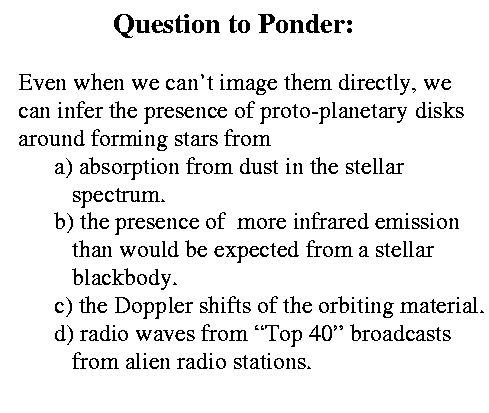|
|
Where timorous knowledge stands considering, Audacious ignorance hath done the deed. Samuel Daniel, c. 1600 |
Assignments:Problem Set #6 due Thursday, 1 April, 5:00pm
|

In Class:
----------------
review:
action in the spiral arms
star formation because of compression of material
molecular cloud formation
gravitational collapse
-> stars get made
tricky parts:
rotation -- makes disks
outflows -- some of the gas falling in gets spat back out
- not well-understood theoretically
- jets emanate perpendicular to the disk
- crash into other (probably unrelated) stuff lying around
- light up "Herbig-Haro objects"
another complication:
multiplicity --> stars mostly form in clusters
- interactions between stars play a role as well
- gravitational competition for material
- jets and outflows stir up the medium
formation of big stars mucks things up
- lots of luminosity
- lots of high energy photons
- dissociated molecules
- even ionizes H atoms --> makes HII regions
- makes cloud turbulent - lots of motion
--> hard for gravity to work
- However, shock waves might actually compress material
that isn't yet vaporized
- might help the star formation process by
increasing the density
- net effect unclear
Eventually SN blow things up
-- everything nearby is blasted to bits,
-- end of star formation (at least locally)
-- means that a typical massive star forming region
last only about 10 million years after it forms its
first O star
- destroyed by its own success
-- on a larger scale, SN might actually foster star formation
- by scooping up material and compressing it.
- shells of compressed material might be the
next site for star formation
------------------------
while the spiral arms are more active than the spots between the sprial arms
- the really active part of our galaxy is toward the center
- densities are a lot higher near the galactic center
- stars are actually closer together there
- there's more dust and gas between the stars
- and it's warmer there
Consequently the galactic nucleus is a pretty active place
Unfortunately, it's also invisible optically
- need to look with longer wavelengths, infrared, radio
- what we know if from these long wavelength investigations
- Infrared studies
- lots of individual stars packed really close together
- lots of warm gas between the stars
- xray and gamma rays indicate huge stars
so closely packed together that they're feeding each
other material
- radio studies
- immense amounts of gas over larger scales
- lots of fuel for star formation
- ring surrounding the center
- 6pc inner edge; 25pc outer edge
- some is spiraling into the very center of the gax
- net picture
- something is eating the galaxy!
- stuff is spiraling down a hole
- can there be a black hole at the center of the galaxy?
- find black holes by measuring their mass and size
- small massive objects are black holes
-measuring mass
- best way -- find something orbiting whatever you want the mass of
- acceleration due to gravity = GM/R^2
- centrifugal acceleration due to circular orbit = v^2/R
- these are equal is the orbit is stable
- M = v^2R/G
- we've done this for the Earth around the Sun
and the Sun around the galaxy
We can apply this to anything orbiting some mass, so let's
try at the galactic center
- measure speed of gas
- one side approaching
- other side receding
gas moves with speed 700 km/s
within 20000 A.U. of the center
M = v^2 R/G
v = 7 x 10^5 m/s
R = 20000 x 1.5 x 10^11 = 3 x 10^15 m
M = (7x10^5)^2 3 x 10^15/6.67 x 10^-11
= 2.2 x 10^37, or 10^7 M_o
10 million solar masses of material within 20000 AU
that's a high density
there are no stars within 20000 AU of the Sun
we do not see that mass of stars in the galactic center
- not even close
only other real possibility is a massive black hole
Note: stellar black holes are 3-10 solar masses
this one's 10 million solar masses
- same kind of beast, but MUCH bigger
- it's probably the remains of many earlier epochs of
massive star formation
- massive stars don't live that long
- then blow up and die, leaving NS or stellar BH
- after a few generations of star formation, there
are a lot of these
-- they collide and coalesce
-- make one big BH
- still being fed
- gas directly
- gas converted to stars and then eaten
Will this monster eat our whole galaxy?
- probably not
- it would take a long time for all of the mass in our gax
to fall down that hole
- e.g., we're pretty far away
|
![]()